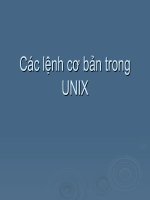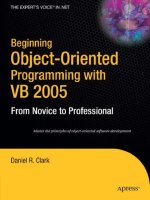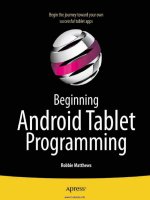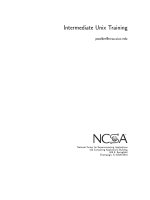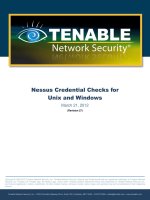Beginning Unix pot
Bạn đang xem bản rút gọn của tài liệu. Xem và tải ngay bản đầy đủ của tài liệu tại đây (8.63 MB, 480 trang )
www.it-ebooks.info
01_579940 ffirs.qxd 3/21/05 5:57 PM Page ii
www.it-ebooks.info
Beginning Unix
®
01_579940 ffirs.qxd 3/21/05 5:57 PM Page i
www.it-ebooks.info
01_579940 ffirs.qxd 3/21/05 5:57 PM Page ii
www.it-ebooks.info
Beginning Unix
®
Paul Love, Joe Merlino, Craig Zimmerman,
Jeremy C. Reed, and Paul Weinstein
01_579940 ffirs.qxd 3/21/05 5:57 PM Page iii
www.it-ebooks.info
Beginning Unix®
Published by
Wiley Publishing, Inc.
10475 Crosspoint Boulevard
Indianapolis, IN 46256
www.wiley.com
Copyright © 2005 by Wiley Publishing, Inc., Indianapolis, Indiana
Published simultaneously in Canada
ISBN 13: 978-0-7645-7994-3
ISBN 10: 0-7645-7994-0
Manufactured in the United States of America
10 9 8 7 6 5 4 3 2 1
1MA/RR/QU/QV/IN
No part of this publication may be reproduced, stored in a retrieval system or transmitted in any form
or by any means, electronic, mechanical, photocopying, recording, scanning or otherwise, except as
permitted under Sections 107 or 108 of the 1976 United States Copyright Act, without either the prior
written permission of the Publisher, or authorization through payment of the appropriate per-copy fee
to the Copyright Clearance Center, 222 Rosewood Drive, Danvers, MA 01923, (978) 750-8400, fax (978)
646-8600. Requests to the Publisher for permission should be addressed to the Legal Department,
Wiley Publishing, Inc., 10475 Crosspoint Blvd., Indianapolis, IN 46256, (317) 572-3447, fax (317)
572-4355, e-mail:
Limit of Liability/Disclaimer of Warranty: The publisher and the author make no representations or
warranties with respect to the accuracy or completeness of the contents of this work and specifically
disclaim all warranties, including without limitation warranties of fitness for a particular purpose. No
warranty may be created or extended by sales or promotional materials. The advice and strategies con-
tained herein may not be suitable for every situation. This work is sold with the understanding that the
publisher is not engaged in rendering legal, accounting, or other professional services. If professional
assistance is required, the services of a competent professional person should be sought. Neither the
publisher nor the author shall be liable for damages arising herefrom. The fact that an organization or
Website is referred to in this work as a citation and/or a potential source of further information does not
mean that the author or the publisher endorses the information the organization or Website may provide
or recommendations it may make. Further, readers should be aware that Internet Websites listed in this
work may have changed or disappeared between when this work was written and when it is read.
For general information on our other products and services or to obtain technical support, please
contact our Customer Care Department within the U.S. at (800) 762-2974, outside the U.S. at
(317) 572-3993 or fax (317) 572-4002.
Wiley also publishes its books in a variety of electronic formats. Some content that appears in print
may not be available in electronic books.
Library of Congress Cataloging-in-Publication Data: Available from publisher
Trademarks: Wiley, the Wiley Publishing logo, Wrox, the Wrox logo, Programmer to Programmer and
related trade dress are trademarks or registered trademarks of John Wiley & Sons, Inc. and/or its affil-
iates, in the United States and other countries, and may not be used without written permission. Unix
is a registered trademark of Unix System Laboratories, Inc. All other trademarks are the property of
their respective owners. Wiley Publishing, Inc., is not associated with any product or vendor men-
tioned in this book.
01_579940 ffirs.qxd 3/21/05 5:57 PM Page iv
www.it-ebooks.info
About the Authors
Paul Love (Cincinnati, OH), CISSP, CISA, CISM, Security+, has been in the IT field for 15 years. Paul
holds a Masters of Science degree in Network Security and a Bachelor’s in Information Systems. He has
co-authored two Linux security books, contributed to multiple Linux/Unix books, and has been the
technical editor for over 10 best selling Linux and Unix books. Paul also ran a successful Linux portal
site during the dot com era and has been an avid Unix/Linux user and administrator both professionally
and as a hobby for many years.
Joe Merlino (Boston, MA) is an experienced system administrator with Unix and Linux for more than a
decade.
Craig Zimmerman (New York, NY) manages UNIX, Macintosh, and Windows systems for Spontaneous,
a post-production company in New York City. He previously worked at Chiat/Day helping build the
world’s most famous virtual advertising agency, managing and networking Unix and Macintosh sys-
tems in multiple offices.
Jeremy C. Reed (Marysville, WA) is a programmer, a member of NetBSD, and has actively taught
FreeBSD, NetBSD, and OpenBSD administration classes for the past three years.
Paul Weinstein (Chicago, IL) has worked on various Unix-based computing platforms, from the main-
frame (Harris HCX-9) to the desktop (Powerbook G4) and has developed applications on just about all
of the current major branches of Unix in the course of the past 10 years. Recently he has been focusing
a lot of his attention on developing and integrating Web-based systems using tools such as Linux,
Apache, MySQL, and Perl, and in doing so has brought his unique understanding to a wide range of
computing environments ranging from public elementary schools to pioneering open source companies.
Currently, Paul works as President and Chief Consultant for the computer consulting firm Kepler
Solutions, Inc.
David Mercer (Cape Town, South Africa) is a long-time Unix user and PHP programmer who con-
tributed to Beginning PHP4 and Beginning PHP5. He has maintained a keen interest in all things open
source ever since he managed to put together a working Beowulf cluster by nicking old computer parts
from colleagues and assembling them under his desk.
01_579940 ffirs.qxd 3/21/05 5:57 PM Page v
www.it-ebooks.info
01_579940 ffirs.qxd 3/21/05 5:57 PM Page vi
www.it-ebooks.info
Credits
Acquisitions Editor
Debra Williams
Development Editor
Maryann Steinhart
Production Editor
Felicia Robinson
Technical Editors
Robert Berg
John Kennedy
David Mercer
David Bruce
Copy Editor
Publication Services
Editorial Manager
Mary Beth Wakefield
Vice President & Executive Group Publisher
Richard Swadley
Vice President and Publisher
Joseph B. Wikert
Project Coordinator
Erin Smith
Graphics and Production Specialists
April Farling
Carrie A. Foster
Lauren Goddard
Denny Hager
Lynsey Osborn
Quality Control Technicians
Amanda Briggs
Brian H. Walls
Proofreading and Indexing
TECHBOOKS Production Services
01_579940 ffirs.qxd 3/21/05 5:57 PM Page vii
www.it-ebooks.info
01_579940 ffirs.qxd 3/21/05 5:57 PM Page viii
www.it-ebooks.info
Contents
Acknowledgements xix
Introduction xxi
Who Is This Book For? xxi
What Does This Book Cover? xxii
How This Book Is Structured xxii
What Do You Need to Use This Book? xxv
Conventions xxv
Source Code xxv
Errata xxv
Chapter 1: Unix Fundamentals 1
Brief History 1
Unix Versions 2
Operating System Components 3
Unix Kernel 4
Shells 5
The Other Components 5
Summary 8
Chapter 2: First Steps 9
System Startup 9
Logging In and Out of Unix 13
Logging In via GUI 14
Logging In at the Command Line 17
Remotely Logging In 20
The Shell 24
Logging Out 24
System Shutdown 24
Getting Help with Man Pages 25
Summary 28
02_579940 ftoc.qxd 3/21/05 5:56 PM Page ix
www.it-ebooks.info
x
Contents
Chapter 3: Understanding Users and Groups 29
Account Basics 29
Root Account 29
System Accounts 30
User Accounts 30
Group Accounts 30
Managing Users and Groups 31
/etc/passwd 31
/etc/shadow 34
/etc/group 37
Mac OS X Differences 39
Managing Accounts and Groups 40
Account Management 41
Group Management 43
User Management with Graphical User Interface Tools 44
Becoming Another User 46
User- and Group-Related Commands 47
Summary 50
Exercises 50
Chapter 4: File System Concepts 53
File System Basics 53
Directory Structure 54
Root’s Basic Directories 55
Paths and Case 56
Navigating the File System 57
pwd 58
cd 58
which and whereis 59
find 60
file 60
ls 61
File Types 63
Links 63
File and Directory Permissions 68
Changing Permissions 69
Using chmod in Symbolic Mode 69
Using chmod with Absolute Permissions 70
Viewing Files 71
02_579940 ftoc.qxd 3/21/05 5:56 PM Page x
www.it-ebooks.info
xi
Contents
Creating, Modifying, and Removing Files 72
Deleting Files 73
Making and Removing Directories 74
Basic File System Management 74
Making File Systems Accessible 77
Summary 79
Exercise 80
Chapter 5: Customize Your Working Environment 81
Environment Variables 81
The PS1 Variable 81
Other Environment Variables 83
Understanding the Path 83
The PATH Environment Variable 84
Relative and Absolute Paths 85
Moving around the File System 86
Choosing a Shell 86
Changing a Shell Temporarily 87
Changing the Default Shell 87
Which Shell? 88
Configuring Your Shell 93
Run Control Files 93
Environment Variables 98
Aliases 101
Options 101
Dynamic Shared Library Paths 102
LD_LIBRARY_PATH 103
LD_DEBUG 103
Summary 104
Exercises 104
Chapter 6: Unix Commands In-Depth 105
Anatomy of a Command 106
Finding Information about Commands 108
man 109
info 109
apropos 110
Command Modification 111
Metacharacters 111
Input and Output Redirection 112
02_579940 ftoc.qxd 3/21/05 5:56 PM Page xi
www.it-ebooks.info
xii
Contents
Pipes 114
Command Substitution 114
Working with Files and Directories 115
ls 115
cd 116
Common File Manipulation Commands 116
cat 116
more/less 117
mv 117
cp 118
rm 118
touch 118
wc 118
File Ownership and Permissions 119
File Ownership 119
File Permissions 120
umask 121
Executable Files 122
Maintaining File System Quotas 122
Summary 124
Exercise 124
Chapter 7: Editing Files with Vi 125
Using Vi 126
Moving within a File 128
Searching Files 133
Exiting and Saving a File 133
Editing Files 134
Deleting Characters 136
Change Commands 137
Advanced Commands 139
Help! 141
Running Commands 143
Replacing Text 143
Versions of Vi 146
Summary 147
Exercises 147
Chapter 8: Advanced Tools 149
Regular Expressions and Metacharacters 149
Understanding Metacharacters 150
Regular Expressions 154
02_579940 ftoc.qxd 3/21/05 5:56 PM Page xii
www.it-ebooks.info
xiii
Contents
Using SFTP and FTP 155
More Advanced Commands 160
grep 160
find 161
sort 163
tee 165
script 165
wc 165
Summary 166
Exercises 166
Chapter 9: Advanced Unix Commands: Sed and AWK 167
Sed 168
Using the -e Option 169
Sed Files 170
Sed Commands 171
AWK 173
Extracting with AWK 174
Working with Patterns 175
Programming with AWK 176
Summary 178
Exercises 179
Chapter 10: Job Control and Process Management 181
What Is a Process? 181
Shell Scripts 182
What Processes Are Running? 183
ps Syntax 184
Process States 185
System Processes 185
Process Attributes 188
Stopping Processes 189
The Process Tree 191
Zombie Processes 192
The top Command 192
The /proc File System 194
SETUID and SETGID 195
Shell Job Control 196
Summary 198
02_579940 ftoc.qxd 3/21/05 5:56 PM Page xiii
www.it-ebooks.info
xiv
Contents
Chapter 11: Running Programs at Specified Times 199
System Clock 199
Checking and Setting the System Clock with Date 200
Syncing Clocks on Linux with hwclock 201
Syncing the System Clock with NTP 201
Scheduling Commands to Run in the Future 202
Routine Execution with Cron 202
One-Time Execution with at 209
Summary 211
Exercise 211
Chapter 12: Security 213
The Basics of Good Security 213
Assets Worth Protecting 214
Potential Issues 214
Securing Your Unix System 215
Password Security 216
Password Discovery Programs 216
Limiting Administrative Access 217
UID 0 217
Root Management Options 218
Setting up Sudo 218
System Administration Preventive Tasks 221
Remove Unneeded Accounts 221
Patch, Restrict, or Remove Programs 222
Disable Unneeded Services 223
Monitor and Restrict Access to Services 223
Implement Built-in Firewalls 224
Other Security Programs 224
Summary 225
Exercise 225
Chapter 13: Basic Shell Scripting 227
Commenting and Documenting Scripts 227
Getting Down to It 229
Invoking the Shell 230
Variables 231
Reading Input from the Keyboard 232
Special Variables 232
Exit Status 232
02_579940 ftoc.qxd 3/21/05 5:56 PM Page xiv
www.it-ebooks.info
xv
Contents
Flow Control 233
Conditional Flow Control 233
Iterative Flow Control 239
Choosing a Shell for Scripting 240
Summary 241
Exercises 241
Chapter 14: Advanced Shell Scripting 243
Advanced Scripting Concepts 243
Input and Output Redirection 244
Command Substitution: Back Ticks and Brace Expansion 246
Using Environment and Shell Variables 246
Shell Functions 247
Returning Values 249
Nested Functions and Recursion 249
Scope 250
Function Libraries 252
getopts 253
Signals and Traps 254
File Handling 255
Arrays 257
Shell Security 260
Where Can Attacks Come From? 260
Taking Precautions 261
Restricted Shells 261
System Administration 263
Gathering Information 264
Performing Tasks 265
Debugging Scripts 265
Summary 267
Exercises 267
Chapter 15: System Logging 269
Log Files 269
Introducing Syslogd 270
Understanding the syslog.conf File 271
What’s the Message? 274
The Logger Utility 275
Rotating Logs 275
02_579940 ftoc.qxd 3/21/05 5:56 PM Page xv
www.it-ebooks.info
xvi
Contents
Monitoring System Logs 276
Logwatch 277
Swatch 279
Summary 281
Exercises 281
Chapter 16: Unix Networking 283
TCP/IP 283
Introducing TCP 283
Introducing IP 284
Other Protocols Used with TCP/IP 284
Network Address, Subnetworks, Netmasks, and Routing with TCP/IP 286
Setting Up a Unix System for a TCP/IP Network 290
Configuring for a TCP/IP Network Request 290
A Dynamic Setup 291
Sending a TCP/IP Network Request 293
Answering a TCP/IP Network Request 295
inetd 296
Network Management Tools 297
Tracking the Performance of a Network with Traceroute 298
Firewalls 300
Routinely Checking Network Latency 300
Summary 302
Exercise 302
Chapter 17: Perl Programming for Unix Automation 303
Perl’s Advantages 305
Useful Perl Commands 305
Variables 306
Operators 306
Basic Functions 307
More Perl Code Examples 313
Troubleshooting Perl Scripts 317
Summary 320
Exercises 320
Chapter 18: Backup Tools 321
Backup Basics 321
Determining What to Back Up 322
Backup Media Types 323
02_579940 ftoc.qxd 3/21/05 5:56 PM Page xvi
www.it-ebooks.info
xvii
Contents
Backup Types 323
When to Run Backups 324
Verify Backups 325
Storing Backups 325
Backup Commands 326
Using tar 326
Compressing with gzip and bzip2 329
cpio 333
dump, backup, and restore 335
Other Backup Commands 340
Backup Suites 341
Summary 341
Exercise 341
Chapter 19: Installing Software from Source Code 343
Understanding Source Code 343
Open Source Licensing 344
BSD Licenses 344
GNU Public License 345
Finding and Downloading Unix Software 346
Choosing Your Software 346
Downloading Files 346
Verify the Source Code 348
Building and Installing 350
Extracting the Files 351
Beginning the Build 352
Introducing make, Makefiles, and make Targets 359
The Makefile 360
Tools to Help Create Makefiles 362
GNU Compilation Tools 363
diff and patch 364
Installation Techniques for Better Maintenance 365
Troubleshooting Build Problems 367
Precompiled Software Packages 367
Summary 369
Exercises 370
Chapter 20: Conversion: Unix for Mac OS Users 371
A Very Brief History of Mac OS X 371
Differences between Mac OS 9 and Mac OS X 372
02_579940 ftoc.qxd 3/21/05 5:56 PM Page xvii
www.it-ebooks.info
xviii
Contents
Folders Are Directories Too 373
Required Folders 374
Home Directory 376
Administration 378
Preference Files 379
Unix and Mac OS X/Mac OS 9 Command and GUI Equivalents 379
Differences between Mac OS X and Other Unix Systems 382
Directory Services and NetInfo 382
Using nidump and niload 384
Backup and Restoration of the NetInfo Database 385
System Startup 385
File Structure Differences 386
Root User Account 387
Summary 388
Exercises 388
Chapter 21: Conversion: Unix for Windows Users 389
Structural Comparison 389
Major Administrative Tools Comparisons 394
Popular Programs Comparison 395
Using Unix within Windows 397
Using Windows within Unix 409
Summary 410
Appendix A: Answers 411
Appendix B: Useful Unix Web Sites 421
Index 425
02_579940 ftoc.qxd 3/21/05 5:56 PM Page xviii
www.it-ebooks.info
Acknowledgments
I would like to thank my family and those who mentored me throughout my career.
I would like to thank the staff at Wiley, particularly Debra Williams Cauley, who helped get this book
started and whose participation during the writing of this book was instrumental in its completion. I
would also like to thank Maryann and the technical editors whose tough first reviews and great insight
helped develop the book into a far greater work. All others at the Wrox team who helped make this book
a better product through their input or editing are greatly appreciated.
Finally, I would like to thank all the developers of the Unix systems and their derivatives. Their tireless
pursuit of excellence has given us one of the most elegant and stable operating systems available today.
—Paul Love
03_579940 flast.qxd 3/21/05 5:56 PM Page xix
www.it-ebooks.info
03_579940 flast.qxd 3/21/05 5:56 PM Page xx
www.it-ebooks.info
Introduction
The new millennium has seen many changes in many areas of computing, from new forms of storage
with massive amounts of storage space, to systems that are far more powerful than the first computer
users could have ever imagined. Designed and initially created more than 30 years ago, the Unix operat-
ing system has been part of the evolution of computers, so it’s no accident that Unix is still one of the
most popular operating systems for mission-critical tasks.
Unix is the basis for some of the most-used operating systems today, from Apple’s Mac OS X to Linux to
the more commonly known Unix versions, such as Sun’s Solaris Unix and IBM’s AIX. Today many of the
versions of Unix are available free to users and corporations, allowing for a larger use base than many
had imagined when Unix was first being developed. Unix is now seen as a user-friendly, very secure,
and robust operating system rather than the cold, command line–only operating system once thought to
be useful only to computer experts.
Beginning Unix covers all basic aspects of the Unix operating system. What is unique about this book is
that it covers not only the standard Unix systems, such as Sun’s Solaris and IBM’s AIX, but also Unix
derivatives, such as Apple’s Mac OS X and the various Linuxes. Additionally, this book includes a
unique conversion section explaining how to convert Mac OS X–specific or Windows operating systems
commands that you may already know into their Unix equivalents, making the transition from other
operating systems much easier.
This book also includes a CD-ROM with the KNOPPIX operating system. This fully functional version of
Linux enables you to restart your computer into a Linux environment. KNOPPIX requires no technical
experience, and it will not damage or modify your current operating system. Using KNOPPIX is an easy
way for you to follow along with the book, learning Unix without the consequences of having to lose
any data or operating systems on your computer.
Who Is This Book For?
This book is for anyone who is interested in understanding the concepts and operation of the Unix oper-
ating system, including any of the Unix derivatives available today (Apple OS X, Linux, or BSD, for
example). It is designed for absolute beginners to the Unix operating system, including those who have
only worked with the many graphical user interfaces available for the different Unix systems (Apple’s
Aqua interface, KDE, GNOME, and so forth). This book can also be useful for veteran Unix users,
because no one knows everything about Unix, as a refresher on known concepts or as a tool to fill gaps
in some knowledge areas.
No assumptions are made about the reader’s skill level or prior use of computers. If you have used com-
puters and other operating systems such as Mac OS X or Microsoft Windows, you will understand some
of the concepts faster, but all readers will gain some insight from this book, regardless of their present
expertise.
03_579940 flast.qxd 3/21/05 5:56 PM Page xxi
www.it-ebooks.info
xxii
Introduction
What Does This Book Cover?
This book covers all versions of Unix in their most basic form, as well as commands and concepts com-
mon to all versions of Unix and its derivatives, including:
❑ Apple’s Mac OS X
❑ Red Hat Linux
❑ Mandrakelinux
❑ IBM’s AIX
❑ Any version of Linux
❑ Any version of BSD (FreeBSD, OpenBSD, NetBSD)
Special emphasis is placed on Sun’s Solaris, Mac OS X, and Linux because they are the most popular
available. The different versions of Unix utilize the same principles and commands with small differ-
ences, so any version of Unix can be used with this book.
This book also covers basic programming, including shell scripting and Perl programming, which
enable you to automate your system as much as possible—one of the strengths of the Unix operating
system. The coverage of these programming concepts creates a firm foundation for more advanced
programming covered by other books.
How This Book Is Structured
This book presents basic concepts of the Unix operating system first, progressing to more advanced top-
ics and programming later in the book. If you are familiar with the concepts or commands covered in
one chapter, you can simply skip to one that has information you need to learn.
Chapters 1 through 4 provide the fundamental information you need to understand Unix methodology,
how Unix is designed, and the basics of logging in to and out of a Unix system.
❑ Chapter 1: Unix Fundamentals. The basics of Unix, including the history and terminology as
well as some of the core concepts of Unix design and philosophy. This chapter helps you under-
stand some of the culture behind the Unix operating system.
❑ Chapter 2: First Steps. This chapter describes the very first steps you must take to utilize the
Unix operating system effectively, including what occurs during the Unix boot process, how to
log in, and how the user environment (shell) is structured, as well as how to shut down a Unix
system properly.
❑ Chapter 3: Understanding Users and Groups. Learning how users and groups work within the
system is crucial to understanding how you can effectively use your system. This chapter covers
all aspects of user accounts and groups, including how to add, modify, and delete user accounts
and how to become another user with the
su command.
❑ Chapter 4: File System Concepts. The Unix file system is one of the most critical components of
the Unix system as a whole. The file system allows you to store and manipulate your files. This
03_579940 flast.qxd 3/21/05 5:56 PM Page xxii
www.it-ebooks.info
xxiii
Introduction
chapter shows you what the Unix file system is and how to use it from a user and system
administrator point of view. You will learn how to utilize the file system effectively, so that you
can prevent some of the common problems associated with file system management.
Chapters 5–7 put you to work, from customizing your working environment to editing files on Unix.
These chapters extend your repertoire of Unix commands.
❑ Chapter 5: Customize Your Working Environment. The shell is the primary environment that
you use for day-to-day work in Unix. Unix offers a multitude of ways to customize your work-
ing environment to suit your needs and whims. This chapter goes over the many different con-
figuration options available for users in many of the different Unix shells.
❑ Chapter 6: Unix Commands In-Depth. Unix has hundreds of different commands that do many
tasks. This chapter provides a foundation for some of the most commonly used commands you
will need to understand in order to use the system effectively for day-to-day work.
❑ Chapter 7: Editing Files with Vi. The vi editor is one of the oldest and most widely used text
editors in Unix. It is commonly seen as a monolithic and difficult-to-use editor, but as you will
learn, it is a very powerful and fast way to edit files. This chapter explores all aspects of using
the vi editor to create and edit files effectively.
With a good foundation in place, you’re ready to move on to more-advanced topics. Chapters 8–11 dis-
cuss how to use some powerful Unix tools, how to manage processes, and how to schedule programs to
run at specific times. Chapter 12 takes on the important subject of security.
❑ Chapter 8: Advanced Tools. This chapter introduces the concept of regular expressions and cov-
ers some of the more advanced tools available to the Unix user.
❑ Chapter 9: Advanced Unix Commands: Sed and AWK.
sed and awk are two very powerful
tools that enable a user to manipulate files in an efficient manner. These commands are essen-
tial, and you will find yourself using them frequently. This chapter goes from the ground up in
showing you how to use these commands.
❑ Chapter 10: Job Control and Process Management. This chapter covers the basics of Unix pro-
cesses and how to control and manage these crucial components of the Unix operating system.
As an extension of processes, job control is reviewed and explained.
❑ Chapter 11: Running Programs at Specified Times. Running programs at specified times with-
out user or administrator intervention provides a user or administrator with the capability to
run programs with minimal system impact when the fewest users are utilizing the system. This
chapter covers how to run commands at different times and discusses the environmental vari-
ables that affect this process.
❑ Chapter 12: Security. Unix has had security features ingrained for many years, but as with any
operating system, it can be made more secure from malicious entities on the outside or inside.
This chapter goes over the basics of system security and then covers some of the fundamental
steps you can take to make your system more secure.
Chapters 13–17 delve into shell scripting and other methods of “automating” common tasks in Unix sys-
tems. Although these tasks often fall within the purview of system administrators, other users, including
home users, may benefit.
03_579940 flast.qxd 3/21/05 5:56 PM Page xxiii
www.it-ebooks.info

